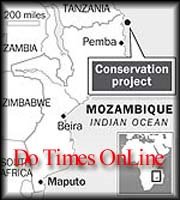
A project to save the hawksbill turtle from extinction has boosted birthrates by 70 per cent in one of the most important nesting regions.
Poaching has been virtually eliminated from nesting sites in Mozambique in a scheme led by conservationists from the Zoological Society of London, which runs London Zoo.
Until the project began three years ago, most of the eggs laid by the critically endangered turtles were dug up by poachers, but close 24-hour monitoring has protected them.
Biologists are now to tag a female hawksbill to track movements from the nesting area and discover more about the turtle’s habits.
The satellite tag will track the turtle’s migratory route for the first time.
Poaching has been virtually eliminated from nesting sites in Mozambique in a scheme led by conservationists from the Zoological Society of London, which runs London Zoo.
Until the project began three years ago, most of the eggs laid by the critically endangered turtles were dug up by poachers, but close 24-hour monitoring has protected them.
Biologists are now to tag a female hawksbill to track movements from the nesting area and discover more about the turtle’s habits.
The satellite tag will track the turtle’s migratory route for the first time.
It will be displayed on a website so the public can monitor progress daily.
Little was known about the nesting sites until the conservation project started but they are now recognised as among the most important in Africa for the turtle.
The nests are found on beaches on three small islands off the coast of Mozambique in an area which is about six hours’ drive from Pemba, the nearest town.
Biologists have now identified 50 hawksbill nests on the beaches, which stretch for more than 10 miles, with an average of 104 eggs per clutch.
Little was known about the nesting sites until the conservation project started but they are now recognised as among the most important in Africa for the turtle.
The nests are found on beaches on three small islands off the coast of Mozambique in an area which is about six hours’ drive from Pemba, the nearest town.
Biologists have now identified 50 hawksbill nests on the beaches, which stretch for more than 10 miles, with an average of 104 eggs per clutch.
They estimate that more than 4,400 young turtles managed to hatch and make their way successfully to the sea last year, at least 70 per cent more than before the project began.
The number of turtle egg nests in the area, including 315 green turtle nests, has astonished conservationists, who had thought that there were just a handful. “This indicates how important the beaches are for hawksbills as no other beaches in East Africa are known to have such high numbers,” said Alison Shaw, of the society.
Researchers have found that the turtles return to the same beach to lay eggs up to eight times in a season, choosing nesting sites very close to their previous nests.
The peak time for laying eggs is the first four months of the year.
The number of turtle egg nests in the area, including 315 green turtle nests, has astonished conservationists, who had thought that there were just a handful. “This indicates how important the beaches are for hawksbills as no other beaches in East Africa are known to have such high numbers,” said Alison Shaw, of the society.
Researchers have found that the turtles return to the same beach to lay eggs up to eight times in a season, choosing nesting sites very close to their previous nests.
The peak time for laying eggs is the first four months of the year.
Monitoring and patrolling are carried out all year round by workers who are recruited locally.
The satellite tag is expected to cast more light on the species and genetic samples are to be taken in the hope that they will help to identify migratory routes.
Ms Shaw added: “We hope the satellite tag will enable us to track the turtles as they migrate across the Indian Ocean. By knowing their patterns of movement, we will be able to better safeguard them and make sure that they return to our beaches to nest again.
“The project has demonstrated the importance of training and employing local monitors, and the transfer of skills for turtle conservation and research in Mozambique.”
Funding for the tag comes from the society and the European Association of Zoos and Aquaria ShellShock campaign.
The satellite tag is expected to cast more light on the species and genetic samples are to be taken in the hope that they will help to identify migratory routes.
Ms Shaw added: “We hope the satellite tag will enable us to track the turtles as they migrate across the Indian Ocean. By knowing their patterns of movement, we will be able to better safeguard them and make sure that they return to our beaches to nest again.
“The project has demonstrated the importance of training and employing local monitors, and the transfer of skills for turtle conservation and research in Mozambique.”
Funding for the tag comes from the society and the European Association of Zoos and Aquaria ShellShock campaign.
By Lewis Smith, Environment Reporter -
The Times
August 04, 2006
The Times
August 04, 2006


Best regards from NY!
ResponderEliminar»